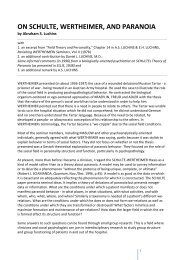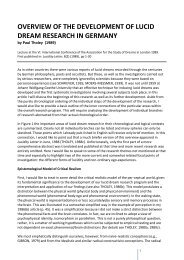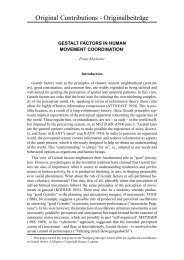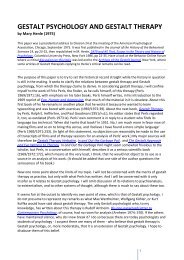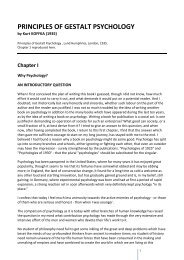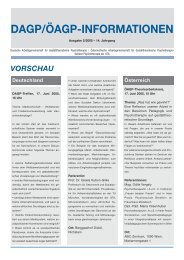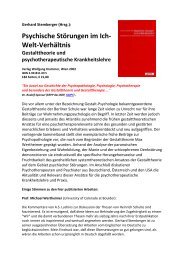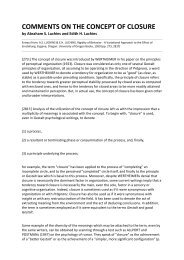pdf-Download - Society for Gestalt Theory and its Applications (GTA)
pdf-Download - Society for Gestalt Theory and its Applications (GTA)
pdf-Download - Society for Gestalt Theory and its Applications (GTA)
Create successful ePaper yourself
Turn your PDF publications into a flip-book with our unique Google optimized e-Paper software.
"I was just coming to that," continues Friedrich. "PIAGET has suggested that the nature of<br />
intelligence (I'd call it the principle of steady productive solutions to problems) is in the balance<br />
between assimilation <strong>and</strong> accommodation (i.e. the adjustment of one's own categories to the<br />
peculiarities of the 'stranger' with whom one enters into a relationship). Hence I would like to say<br />
to PERLS - though, in contrast to you, Theo, I'm only referring to the theoretical part of his work: In<br />
spite of the justified rejection of a process which is nothing but the <strong>for</strong>ced 'introjection' of<br />
indigestible chunks, the regulating process of accommodation, i.e. the adjustment of one's own<br />
categories of recognition to the factual structure of what is to be recognised (e.g. the present<br />
terminology of <strong>Gestalt</strong> theory) is greatly neglected in a tendency towards exuberant assimilation<br />
(1980, p. 116). This becomes especially salient, <strong>for</strong> instance, when PERLS, HEFFERLINE <strong>and</strong><br />
GOODMAN name the <strong>Gestalt</strong> theoretical differentiation between figure <strong>and</strong> ground as the basic<br />
concept of <strong>Gestalt</strong> therapy <strong>and</strong> <strong>its</strong> underst<strong>and</strong>ing of psychical processes. It is obvious that in this<br />
presupposition the <strong>Gestalt</strong> theoretical concepts of figure/ground on the one h<strong>and</strong> <strong>and</strong> centering<br />
on the other are confused, <strong>and</strong> thus the concept of figure/ground is strained to the point of<br />
becoming unfathomable (simply because it is really centering which is talked about). -In this socalled<br />
theoretical foundation of <strong>Gestalt</strong> therapy we have to look <strong>for</strong> clearly stated findings amidst<br />
this flood of assimilation, <strong>and</strong> there are indeed things to be discovered:<br />
"1. It appears to me that the necessary, but at the same very difficult integration of <strong>Gestalt</strong> theory<br />
<strong>and</strong> psychoanalysis has been successful despite the occasional hitch when it comes to a precise<br />
terminology. This is a huge step <strong>and</strong> the reason why the volume concerned with practical matters<br />
(the second volume by PERLS, HEFFERLINE <strong>and</strong> GOODMAN) is so fascinating.<br />
"2. I found the explanations in the volume about practical matters gripping <strong>and</strong> very enlightening.<br />
The book contains a fascinating demonstration of how an increasing awareness of the perception<br />
of external circumstances leads to an increasing awareness of internal processes. This makes clear<br />
the connection, perhaps even unity, of 'purely' perceptive, emotional, <strong>and</strong> motor processes, which<br />
constitutes a phenomenon which has not been sufficiently emphasised by the Berlin School of<br />
<strong>Gestalt</strong> theory, even though it was never overlooked. I have got to accept this criticism coming<br />
from PERLS <strong>and</strong> his colleagues even though I am a follower of the Berlin School myself (HOETH,<br />
1980, 116).<br />
"I used to have another suspicion - i.e. that PERLS tempted his patients into becoming assimilation<br />
fanatics -, but have not been able to find evidence <strong>for</strong> this, either. On the contrary: PERLS, who is a<br />
brilliant phenomenologist, implies in his practical explanations <strong>and</strong> quite possibly also in his<br />
practical therapy the duty of others towards accommodation by dem<strong>and</strong>ing that they develop<br />
categories of perception which would make possible an awareness of the phenomena, which<br />
become clear in his view. - Perhaps the therapeutic practitioner PERLS is ahead of the theoretician<br />
PERLS? - Integration is certainly necessary. I believe that so-called academic psychology ought to<br />
deal with PERLS's work in great detail (1980, 117).<br />
That's it <strong>for</strong> the moment," closes Friedrich. "You're a tolerant man," remarks Theo with a quick<br />
side-glance at Fritz. The latter underst<strong>and</strong>s what is meant by it <strong>and</strong> suggests, "Perhaps Paul is yet<br />
to roast me."<br />
Paul: "That's not the point, but there is something which I do think is important: In <strong>Gestalt</strong> therapy<br />
dreams play a crucial role. PERLS calls the dream the 'royal way to integration' in an attempt to<br />
distinguish himself as a <strong>Gestalt</strong> theoretician from FREUD, who called it the 'royal way to the<br />
unconscious'. However, PERLS remains rooted in psychoanalysis <strong>and</strong> basically in the same<br />
8



